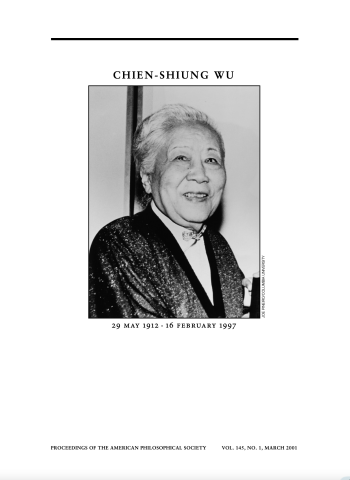CHIEN-SHIUNG WU 29 May 1912-16 February 1997

EARLY IN 1997, Chien-Shiung Wu was selected by the Columbia University chapter of Sigma Xi to receive its Distinguished Scholar Award. On such an occasion it is usual for the recipient to deliver a talk on his (in this case, her) research. Because of her failing health, she and her husband, Dr. Luke Yuan, asked that I speak in her place.
I was one of Chien-Shiung’s earliest graduate students. We were friends and, on occasion over the years, co-investigators. I agreed to give the talk and planned to prepare the material with her in the time that was available before it was to be given. However, she died just a few days after we spoke.
The talk that I gave is based upon her work—admittedly colored by my personal relationship with her as her graduate student, her friend, and a colleague for nearly a half century. The talk covered only a small sample of her work over a very productive lifetime.
I am grateful to her husband, Luke, for providing me with additional information and insights into the period before Chien-Shiung and I knew each other.
This piece is derived from that talk.
In Dr. Wu’s opinion, the existing measurements were of such poor quality that they could not permit any conclusion to be reached. [This is not a reference to RR but to earlier beta decay experiments.] But in her philosophy, it wasn’t enough that you simply say that someone else’s work was wrong. Rather, it was necessary for you to identify any faults in its techniques or design, then show how those would have led to errors. Finally, and most important, it was up to you to develop ways to do it right, and then, to do it! And she did!
,As the Pupin Laboratories were being brought back to their prewar condition, Dr. Wu had discovered an iron-free solenoidal beta-spectrometer that had been placed in storage to make space for the wartime research. She recognized the potential advantages it could offer. Together with several of her graduate students, she brought the solenoidal spectrometer back to operating condition and modified its design to optimize its transmission and to permit the use of large-area, hence thinner, sources. They worked on techniques to disperse the source material as uniformly as possible to minimize the maximum source thickness. Finally, they placed those sources onto very thin, electrically-conducting backings to avoid back-scatter and source charging.
,In our lives, each of us encounters challenges and opportunities, but not all of us can recognize them, can integrate them in the context of our individual experiences and thought, and can thus act on them to our own advantage. In Chien-Shiung Wu’s life, there were many milestones of varying significance, in which she made choices. Because of her talents and the perspective she brought to bear on those occasions, she accomplished many things that have led to the honors she received and deserved.